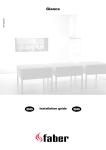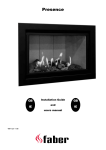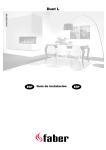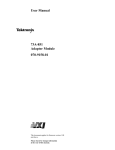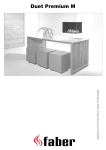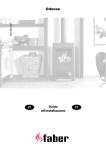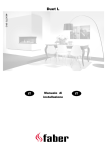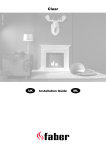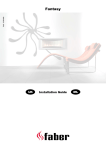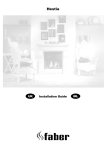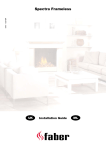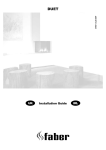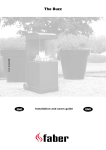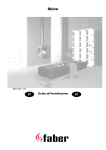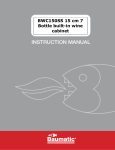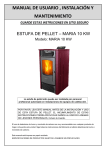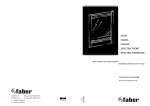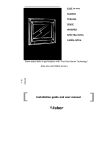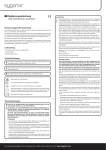Download Triple XL Gas Fire
Transcript
Triple XL
40010790-0929
ENG
Installation Manual
ENG
30cm
L
1.1
1.2
1.3
1.4
1.5
A
1.6
1<<<<
1.7
L
B
A
2<<<<
2.1
2.2
2.3
2.4
L
3<<<<
2.5
2.6
2.7
2.8
L
4.1
F
F
4.2
4.3
4<<<<
L
Table of contents
1
Introduction ......................................................................................... 7
2
Safety instructions.................................................................................. 7
3
Installation requirements ......................................................................... 8
3.1
The fire ........................................................................................ 8
3.2
False Chimney breast ........................................................................ 8
3.3
Requirements flue system and outlets.................................................... 8
3.4
terminals ...................................................................................... 9
4
Preparation and Installation instructions ....................................................... 9
4.1
Gas connection ............................................................................... 9
4.2
Electric connection .......................................................................... 9
4.3
Preparation of the appliance............................................................... 9
4.4
Placing the appliance....................................................................... 10
4.5
Mounting the smoke emission outlet materials ........................................ 10
4.6
Building a false chimney breast........................................................... 10
4.7
False Chimney breast ....................................................................... 11
4.8
Frameless without optional decorative sheet .......................................... 11
4.9
Frameless with optional decorative sheet .............................................. 11
5
removing the glass................................................................................. 11
5.1
removing the glass in front ................................................................ 11
5.2
removing the glass on the side............................................................ 11
6
Plaatsen van het decoratiemateriaal........................................................... 12
6.1
Imitation logs ................................................................................ 12
6.2
Pebbles ....................................................................................... 12
7
Checking the installation. ........................................................................ 13
7.1
Checking the ignition of the pilot burner, main burner............................... 13
7.2
Checking for gas leakage................................................................... 13
7.3
Checking the burner pressure and the pre-pressure .................................. 13
7.4
Checking the flame picture................................................................ 14
8
Instructing the client.............................................................................. 14
9
Annual maintenance .............................................................................. 15
9.1
Service and cleaning:....................................................................... 15
9.2
Replace: ...................................................................................... 15
9.3
Cleaning the glass ........................................................................... 15
10
Conversion to a different type of gas (e.g. propane) .................................... 15
5<<<<
L
11
Calculation of flue system .................................................................... 16
11.1
Points of particular interest: .............................................................. 16
11.2
Sample calculation.......................................................................... 17
12
Table ............................................................................................. 18
13
Technical data .................................................................................. 19
14
Dimentions of the appliance ................................................................. 20
15
Dimentions of the appliance with decoration plate ...................................... 21
16
Dimentions of decoration plate .............................................................. 22
17
Dimentions ventilatie grills ................................................................... 23
18
Dimention service Hatch ...................................................................... 24
6<<<<
L
1 Introduction
The appliance can only be installed by a competent person in accordance with the Gas
Safety. We urgently advise you to read this installation manual properly.
This appliance complies with the guidelines for European gas appliances (Gas Appliances
Directive) and bears the CE mark.
2 Safety instructions.
•
The appliance should be placed, connected and annually checked in accordance
with these installation instructions and valid national and local Gas Safety
(Installation and Use) Regulations .
•
Check whether the data on the registration plate are in agreement with the local
type of domestic gas and pressure.
•
The fitter is not permitted to change these adjustments or the construction of the
appliance!
•
Do not place any additional imitation logs or glowing coals on the burner or in the
combustion chamber.
•
The appliance has been designed for ambience and heating purposes. This means
that all surfaces of the appliance , including the glass, can become very hot (hotter
than 100 °C). An exception to this are the bottom of the appliance and the
controls.
•
Do not place any inflammable materials within a of 0.5 m. of the radiation of the
appliance and ventilation grills.
•
Due to natural air circulation of the appliance, moisture and volatile components
from paint, building materials, floor coverings etc. that haven’t yet set, can be
drawn through the convection system and can be deposited on cold surfaces as
soot. That is why you should not use the appliance shortly after a renovation.
•
The first time the appliance is switched on, Let the fire run on maximum setting for
several hours so that the lacquer coating will have an opportunity to set and
possible vapors released can be safely removed by ventilation. We advise you to be
outside the room as much as possible during this process!
•
Please note that:
1. all transport packaging should be removed.
2. children or pets should not be present in the room.
7<<<<
L
3 Installation requirements
3.1
•
The fire
The appliance must be built into an existing or a newly to be constructed false
chimney breast.
•
In appliances with flexible gas pipes, the gas control valve is mounted to the right
side of the fire for safe transport . Unscrew it and mount it at a distance of max. 30
cm behind the access door.
•
The receiver which has been attached in a transport holder (see fig. 1.5 A) to the
side of control valve bracket, can now be slid onto the top of the control valve
bracket. The transport holder can be removed now.
3.2
False Chimney breast
•
The false chimney breast must be constructed of an non-combustible material.
•
Always ventilate the space above the appliance by means of the grills or a
comparable alternative with a minimum air supply of 200 cm².
•
For the finish, use special stucco (min. 100°C resistant) or glass fiber wallpaper to
prevent discoloration or cracks etc. Recommended drying time: for plaster is a
minimum of 24 hours per mm of coat applied.
•
The false chimney breast and its construction may not rest on the appliance
3.3
•
Requirements flue system and outlets
You should always make use of the materials prescribed by Faber International Ltd.
Only by using these materials can Faber International Ltd. guarantee a proper
functioning.
•
The outside of the concentric flue material can reach a temperature of
Approx 150°C. Make sure of proper isolation and protection in case of transit
through combustible wall or ceiling constructions. And observe sufficient distance.
•
Make sure that the concentric flue materials are bracketed every 2 meters when
they have an extended length, so that the weight of the flue material is not resting
on the appliance itself.
•
You may never start with a cut-down concentric pipe directly on to the appliance.
8<<<<
L
3.4
terminals
The flue outlet can end on an external wall or a roof . Check whether the outlet desired
by you complies with local requirements concerning good function and ventilation
systems .
For a proper functioning the terminal should be at least 0.5 m. away from:
•
Corners of the building.
•
Roof overhangs and balconies.
•
Eaves (with the exception of the roof ridge).
4 Preparation and Installation instructions
4.1
Gas connection
The gas connection must comply with locally valid standards.
We advise Pipe work from the meter to the appliance must be of adequate size., with near
the appliance a gas isolator tap that should always be accessible. Place the gas connection
in such a way that this is easily accessible, and that before service, the burner unit can be
disconnected at all times.
4.2
Electric connection
If an adapter is used for the power supply, then a wall socket 230VAC – 50Hz must be
mounted in the close neighbourhood of the hearth.
4.3
Preparation of the appliance
•
Remove the packaging of the appliance . Make sure the gas pipes underneath the
appliance are not damaged.
•
Clear a safe space to store the frame and the glass.
•
Remove the frame , (if necessary) and the glass and take the separately wrapped
parts out of the appliance
•
Prepare the gas connection to the gas control valve.
9<<<<
L
4.4
Placing the appliance
Take the installation requirements into account (see chapter 3 )
4.4.1 Standing on the floor
Place the appliance into the proper position and if necessary, adjust the height with the
adjustable legs.
Adjusting the height and leveling the hearth with a spirit level.(see fig. 1.4)
•
Rough height adjustment:
o
•
with the extending legs, or the long additional legs.
Accurate:
o
with the rotating adjustable legs.
4.4.2 Suspended from the wall
The appliance can be mounted suspended from the wall with the use of the suspension
bracket and the Raw plugs supplied (see fig. 1.3). These mounting materials are
exclusively intended for use on walls constructed of brick or concrete. For walls built of
other materials, such as hollow bricks, consult a professional expert.
4.5
Mounting the smoke emission outlet materials
•
In case of a wall or roof terminal, the hole must be at least 5 mm bigger than the
diameter of the flue material.
•
Horizontal parts must be installed at a (3 degree) slope up away the appliance.
•
Build up the system from the appliance. If this is not possible, you should make use
of a adjustable pipe .
•
For fitting the system a ½ meter cut-down pipe should be used. Make sure the
inner pipe is always 2 cm longer than the outer pipe. Wall and roof terminal are
also shortened. These parts must be secured with a self tapping screw.
•
4.6
Do not insulate but ventilate build-in flue material (approx.100cm2)
Building a false chimney breast.
Before constructing the false chimney breast we advise you to perform a function test with
the appliance as described in chapter 7 “checking the installation”
10 < < < <
L
4.7
False Chimney breast
•
Construct the false chimney breast from non- combustible material in combination
with metal profiles or of brickwork / aerated concrete bricks.
•
Take the grills and the service panel (see fig. 1.1 and 1.2 )into account. Place a
protective shield made of non- combustible material above the grills (see fig1.1 A)
•
Always use a lintel if the chimney breast is constructed of brickwork. This should
not be placed directly onto the appliance
4.8
Frameless without optional decorative sheet
•
Construct the false chimney breast against the build-in frame (see fig.1.1 B).
Keep a minimum margin of 3 mm between chimney breast and the appliance in
connection with the expansion of the appliance.
•
4.9
The depth of the recess has no influence on the removal of the glass.
Frameless with optional decorative sheet
•
Construct the false chimney breast around against the build-in frame (see fig.1.1 B)
apart from the lower half. Keep a minimum margin of 3 mm between chimney
breast and the appliance in connection with the expansion of the hearth.
•
The height of the lower half should correspond with the height of the groove(see fig
1.5.)
•
Place the decorative sheet on top the build-in frame.
5 removing the glass
5.1
removing the glass in front
•
Remove the cover strips A on the side. (see fig. 2.1)
•
Remove cover strip B on the bottom. (see fig. 2.2)
•
Place the suction discs onto the glass
•
Remove the sealing cord from the groove (see fig. 2.3)
•
Slide the glass upwards so that it is released from the groove. Now gradually move
the glass outwards and downwards. (see fig. 2.4)
5.2
removing the glass on the side
It is not necessary to take out the glass on the side for placing the artificial logs or for
maintenance purposes.
11 < < < <
L
•
Remove the front glass first.
•
Place the suction discs onto the glass
•
Remove the sealing cord from the groove
•
Slide the glass upwards now, so that the bottom edge is released from the groove.
Now gradually move the bottom edge of the glass forwards slantwise and lower the
glass into the opening between the build-in frame and the appliance. (see fig. 2.5,
2.6 and 2.7)
•
Now gradually move the top edge of the glass forwards and upwards out of the
appliance (see fig. 2.8)
•
To replace the glass repeat the process in reverse order.
Remove all Fingerprints from the glass, these will be burned into it once the hearth is
used.
6 Placing the decoration material
It is not allowed to add different or more materials to the combustion chamber.
Always keep the pilot burner free from decorative material!
Do not toss all the decorative material onto the burner all at once, as the very fine dust
may block the holes in the burner.
6.1
Imitation logs
•
Spread the vermiculate preferably by hand over the tube burners in the burner-slot.
The surface of the pebbles may be very slightly elevated from the burner plate but
it should be level throughout the entire length.
•
Place the imitation logs according to instructions. (see fig. 4.1. or the instruction
card)
•
It is optional whether you apply chips to the combustion chamber or not. Prevent
chips from covering the burner, this has a negative effect on the fire image.
•
Start the pilot en main burner, according to the instructions in the user’s manual.
Assess whether the flame distribution is correct.
•
6.2
Place the glass and check the flame picture into the appliance
Pebbles
•
Remove the burner plates F (see fig. 4.2)
•
Place the pebbles over the burner and the bottom. Spread the pebbles evenly to a
12 < < < <
L
double layer. The surface of the pebbles may be very slightly higher than the
burner tube ( see fig. 4.3)
•
Place the glass and check the flame picture into the appliance
7 Checking the installation.
7.1
Checking the ignition of the pilot burner, main burner.
Start the pilot and main burner according to the instructions in the user’s manual.
•
Check whether the pilot light is properly positioned above the main burner and is
not covered by chips, an imitation log or pebbles.
•
Check the ignition of the main burner at full mark or low mark.
(the ignition should take place quickly and easily).
7.2
Checking for gas leakage.
Check all connections and joins for possible gas leaks by means of a gas leak detector or
spray
7.3
Checking the burner pressure and the pre-pressure
Check whether the burner pressure and the inlet pressure measured agree with the data
indicated on the registration plate
Measuring the inlet-pressure:
•
Turn off the gas control tap.
•
Open the pressure gauge nipple B (see fig. 1.7) a few turns and connect a pressure
gauge hose to the gas control valve.
•
Carry out this measurement when the appliance is on at full gas mark and when it is
on the pilot light.
•
If the inlet pressure is too high you are not permitted to connect the appliance.
Measuring the burner pressure:
Only perform this measurement if the inlet-pressure is correct.
•
Open the pressure gauge nipple A (see fig. 1.7) a few turns and connect a pressure
gauge hose to the gas control valve.
•
The pressure must agree with the value indicated on the registration plate. In case
of deviations, get in touch with the manufacturer.
* Close the pressure gauge nipples and check these for gas leaks.
13 < < < <
L
7.4
Checking the flame picture.
Allow the applaince to burn for at least 20 minutes at full and then check the flame
picture for:
1. Distribution of the flames
2. Colour of the flames
If either one or both points are unacceptable, then check:
•
The positioning of the imitation logs and/or the quantity of pebbles or chips on the
burner.
•
The connections of the Flue materials for leakage (in case of blue flames)
•
Whether the correct flue restrictor has been mounted
•
The outlet .
•
o
Wall terminal is installed correctly
o
Roof terminal is fitted and sited correctly
The flue system is correctly calculated
8 Instructing the client
•
Recommend that the appliance be serviced annually by a competent person in
order to guarantee a safe use and a long lifespan.
•
Advise and instruct the client about maintenance and cleaning of the glass.
Emphasize the risk of burning in fingerprints.
•
Instruct the client about the operation of the appliance and the remote control
unit, including the replacement of the batteries and adjusting the receiver for
initial use.
•
Hand over to the client:
14 < < < <
o
Installation manual
o
User’s manual
o
Imitation logs instruction card
o
Suction lifters
L
9 Annual maintenance
9.1
Service and cleaning:
•
9.2
Check and clean if necessary after checking:
o
The pilot light
o
The burner
o
The combustion chamber
o
The glass
o
The logs for possible fractures
o
The outlet
Replace:
o
9.3
If necessary the chips/embers.
Cleaning the glass
Most of the deposits can be removed with a dry cloth. You can use ceramic hob cleaner to
clean the glass.
Note: prevent fingerprints on the glass. these will be burned into it once the appliance is
used and cannot be removed anymore!
Carry-out the check-up according to the instructions in chapter 7 “checking the
installation’
10 Conversion to a different type of gas (e.g.
propane)
This can only be done by installing the proper burner unit. for this purpose get in touch
with your supplier.
Always mention the type and serial number of the appliance when ordering.
15 < < < <
L
11 Calculation of flue system
The possibilities for the lengths of flue pipes and the possible restrictors have been recorded
in a table (see chapter 12.) This table works with a vertical and a horizontal length.
•
To define the vertical length all lengths of flue pipes in a vertical direction should
be added up.
-
•
The roof terminal always counts as 1 meter.
To define the horizontal length all lengths of flue pipes in a horizontal direction
should be added up.
-
every 90° bend in the horizontal part counts as 2 meters.
-
every 45° bend in the horizontal part counts as 1 meter.
-
Turns from vertical to horizontal or vice versa are not reckoned in the
calculation.
-
The wall terminal always counts as 1 meter.
If there is transit under 45° then the real vertical and horizontal lengths should be
calculated.
11.1 Points of particular interest:
•
In case of a wall terminal, the entire flue system including the wall terminal should
be constructed of 200/130 flue pipes.
•
In case of a roof terminal, the entire flue system should be constructed of 200/130
flue pipes , apart from the roof terminal, which should be constructed of 150/100
and should be connected by means of a reducer.
•
The maximum chimney length is 12 meters.
•
You can never start with a 90° or 45° bend from the appliance.
•
You should always start with 1 meter vertical if the horizontal transit is more than 1
meter.
•
You should never start with a cut-down pipe from the appliance.
16 < < < <
L
11.2 Sample calculation
Sample calculation 1
Count the horizontal lengths
Flue pipe lengths
C+E = 1 + 1
2m
Bend
D=1x2m
2m
Total
4m
Count the vertical lengths
Flue pipe length A
1m
Roof terminal G
Total
1m
2m
Sample calculation 2
Count the horizontal lengths
Flue pipe lengths J + L = 0,5 + 0,5 1 m
Bends
K+ M = 2 + 2 m
4m
Wall terminal
1m
Total horizontal length
6m
Count the vertical lengths
Flue pipe length H
1m
Total
1m
17 < < < <
L
12 Table
Find the correct vertical and horizontal lengths in the table.
In case of an “x”, or if the values are outside the table, the combination is not permitted.
The value found indicates the width of the restrictor to be placed ("0" means no restrictor
should be placed).
Generally a 30mm restrictor is pre-installed
Vertical
Horizontal
18 < < < <
0
1
2
3
4
5
6
0
x
x
x
x
x
x
x
0.5
x
x
x
x
x
x
x
1
x
30
0
0
x
x
x
1.5
40
40
30
30
0
x
x
2
45
40
40
30
0
0
0
3
50
45
40
30
30
0
0
4
60
50
45
40
30
0
0
5
65
60
50
45
30
30
0
6
70
65
60
50
45
30
30
7
70
70
65
60
50
45
x
8
70
70
70
65
60
x
x
9
75
70
70
70
x
x
x
10
75
75
70
x
x
x
x
11
80
80
x
x
x
x
x
12
80
x
x
x
x
x
x
L
13 Technical data
Gascat.
2H3+
2H3+
2H3+
C11 C31
C11 C31
C11 C31
G20
G30
G31
12,2
11
11
Efficiency class
2
2
2
NOx class
4
4
4
mbar
20
30
37
Gas rate at 15ºC and 1013 mbar
l/h
1278
339
432
Gas rate at 15ºC and 1013 mbar
gr/h
850
810
Burner pressure at full mark
mbar
11
24
29,6
Injector main burner
mm
2x 2,5mm
2x 1,3mm
2x 1,3mm
Reduced input restraint
mm
2,1
1,1
1,1
Pilot assembly
SIT160
SIT160
SIT160
Code
Nr.51
Nr.30
Nr.30
200/130
200/130
200/130
Gas control valve
GV60
GV60
GV60
Gas connection
3/8”
3/8”
3/8”
220
220
220
4x AA
4x AA
4x AA
(1,5V)
(1,5V)
(1,5V)
9
9
9
Type appliance
Reference gas
Input Nett
inlet-pressure
Diameter inlet / outlet
kW
mm
Electrical connection
V
Batteries receiver
V
Batteries sender
V
19 < < < <
L
14
Dimensions of the appliance
20 < < < <
L
15
Dimensions of the appliance with decoration
plate
21 < < < <
L
16
Dimensions of decoration plate
22 < < < <
L
17 Dimensions ventilation grills
23 < < < <
L
18 Dimensions service Hatch
24 < < < <
www.faber.nl
-
[email protected]
Saturnus 8
NL - 8448 CC Heerenveen
Postbus 219
NL - 8440 AE Heerenveen
T. +31(0)513 656500
F. +31(0)513 656501




























